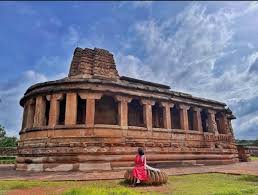Journey Through the Ages: The Evolution of Hindu Temple Architecture in India
The rich tapestry of Indian temple architecture reflects millennia of cultural, religious, and artistic traditions. From the early structures of the Indus Valley Civilization to the grand temples of the classical period, these sacred spaces have continuously evolved, embodying the spiritual and social ethos of their times.
🌟 Historical Evolution:
- Aihole, Karnataka: Birthplace of Indian Temple Architecture (2500 BC): The Durga Temple in Aihole, built by the Chalukyas, is a pioneering example of early temple architecture. Aihole became a hub for architectural innovation, leading to the development of the Vesara style, a blend of Dravidian and Nagara elements. This architectural legacy laid the foundation for future temple designs across India.
- Unveiling the Lost City of Dwarka (2000 BC): The underwater discoveries off the coast of Dwarka, Gujarat, reveal an ancient city with well-aligned stone blocks and advanced architecture. This site offers insights into urban planning and religious architecture between the Indus Valley Civilization and Vedic periods.
- Indus Valley Civilization (1900 BC): This ancient civilization showcased remarkable urban planning, with cities like Mohenjo-Daro featuring grid layouts, advanced drainage systems, and well-constructed houses. The architectural achievements of this period continue to inspire awe for their engineering prowess.
- Kanaganahalli: A Treasure of Buddhist Architecture (1st Century BC–6th Century CE): Kanaganahalli in Karnataka features impressive Buddhist architecture, reflecting the spread of Buddhism in southern India. The site's massive stupa, prayer halls, and intricate sculptures are testament to the artistic mastery of the period.
- Sanchi Stupa (200 BC): Built by Emperor Ashoka, the Sanchi Stupa in Madhya Pradesh is a prominent Buddhist monument. Its hemispherical dome, intricately carved gateways, and spiritual significance make it a timeless symbol of ancient India's architectural and artistic achievements.
- Pre-Mauryan to Gupta Period: The roots of Hindu architecture can be traced back to the Vedic period, with early structures built for religious rituals. The Gupta period, often hailed as the "Golden Age" (4th–6th centuries CE), saw the construction of enduring temple structures like the Dashavatara Temple at Deogarh.
- Classical Period (7th–12th centuries CE): This era witnessed the development of distinct regional styles:
- Nagara (North Indian): Known for its beehive-shaped shikhara, seen in temples like Kandariya Mahadeva in Khajuraho.
- Dravida (South Indian): Characterized by pyramidal vimanas and grand gopurams, exemplified by the Brihadeeswarar Temple in Thanjavur.
- Vesara (Deccan): A blend of Nagara and Dravida styles, visible in the Hoysaleswara Temple at Halebidu.
- Mediaeval to Early Modern Period (13th–18th Century CE): Grand temple complexes flourished in South India under the patronage of dynasties like the Cholas and Vijayanagara. The Rajput architecture of North India also emerged, blending Hindu and Islamic influences.
🏛 Key Architectural Features:
- Geometric Layout: Temples are designed based on the vastu-purusha mandala, orientated towards the east.
- Symbolism: Temples symbolise the cosmos, with the central deity representing the axis mundi. The shikhara or vimana signifies spiritual ascent.
- Sculpture and Ornamentation: Temples are adorned with intricate carvings and sculptures, depicting deities, mythological scenes, and nature motifs.
🛕 Regional Variations:
- North Indian (Nagara): Known for its beehive-shaped shikhara.
- South Indian (Dravida): Marked by ornate gopurams and vimanas.
- Western Indian: Renowned for elaborate marble work.
🏺 Cultural Significance: Temples were not just places of worship but centres of learning, art, and community life. They continue to play a vital role in Hindu society, embodying cultural and religious values.
🚀 Contemporary Influence: Modern temple architecture blends traditional forms with contemporary materials, yet the spiritual symbolism remains at its core.
Did You Know?
The Durga Temple in Aihole, Karnataka, dating back to 2500 BC, is considered the birthplace of Indian temple architecture. Aihole was a pioneering centre for architectural experimentation, leading to the development of the Vesara style, which continues to influence temple design across India.
Join us on this journey through the magnificent history of Indian temple architecture and discover how it has shaped the spiritual and cultural landscape of India.
#IndianArchitecture #TempleArchitecture #CulturalHeritage #HinduTemples #IndusValley #GuptaPeriod #Nagara #Dravida #Vesara #Durgatemple #Vijayanagara #Chalukyas #Aihole #Hampi

Comments
Post a Comment